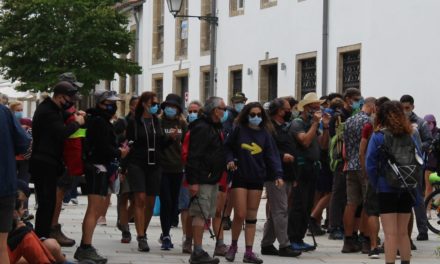The name of the most famous square in Santiago – “obradoiro” in Galician means ‘workshop’ in English – indicates what were the main activities in it for centuries: here were the established workshops of stonemasons, carpenters, glassworkers and all those involved in work on the cathedral. Today, the Obradoiro square is a magical and emotional meeting place that no pilgrim to Compostela can forget.
Throughout the centuries the pilgrims made this become the important point of arrival, since for most of them this was where they gained access to the cathedral, thus passing through the magnificent Portico de la Gloria. In the present-day revival of pilgrimages to Santiago, the Plaza del Obradoiro has become the main meeting point of pilgrims and every day one can witness pilgrims warmly embracing one another when they meet, while others sit on the fine, cobblestoned pavement contemplating the beautiful facade and baroque towers of the cathedral.
The structure of the square is rectangular, a large rectangle whose sides are occupied by four grand buildings: on the two longer sides stand the Cathedral of Santiago and the Pazo de Raxoi, the current headquarters of the city council of Santiago; while on the shorter sides stand the Real Hostal de los Reyes Católicos, a former pilgrim hospital and currently a national parador, and the San Xerome College, seat of the Rector of the University of Santiago de Compostela.
The presence of these magnificent buildings allows those who visit the square to obtain an almost complete vision of the history and art of the city of Compostela, being able to compare the different historical phases that engendered different architectural styles in the city throughout the centuries. Thus, the visitor encounters Romanesque art, which may be seen beyond the façade of the Cathedral, in the magnificent Portico de la Gloria; Gothic art on the sculpted doorway of the College of Xan Xerome, vestige of a previous building; the Renaissance is present on the steps of the cathedral, designed by Ginés Martínez from classic models of the 16th century, as well as the façade and sculpted portico of the Hostal, works dating from the beginning of the 16th century; the Baroque of the façade of the cathedral, designed by Fernando de Casas Novoa; and, finally, the Neoclassicism present in the magnificent palace of the town hall, the work of the architect José Ferreiro.
To these buildings should also be added the two edifices flanking the cathedral: the well-known Palace of Gelmírez and the current Museum of the Cathedral, both of them representing a period of transition between Romanesque and Gothic architecture.











